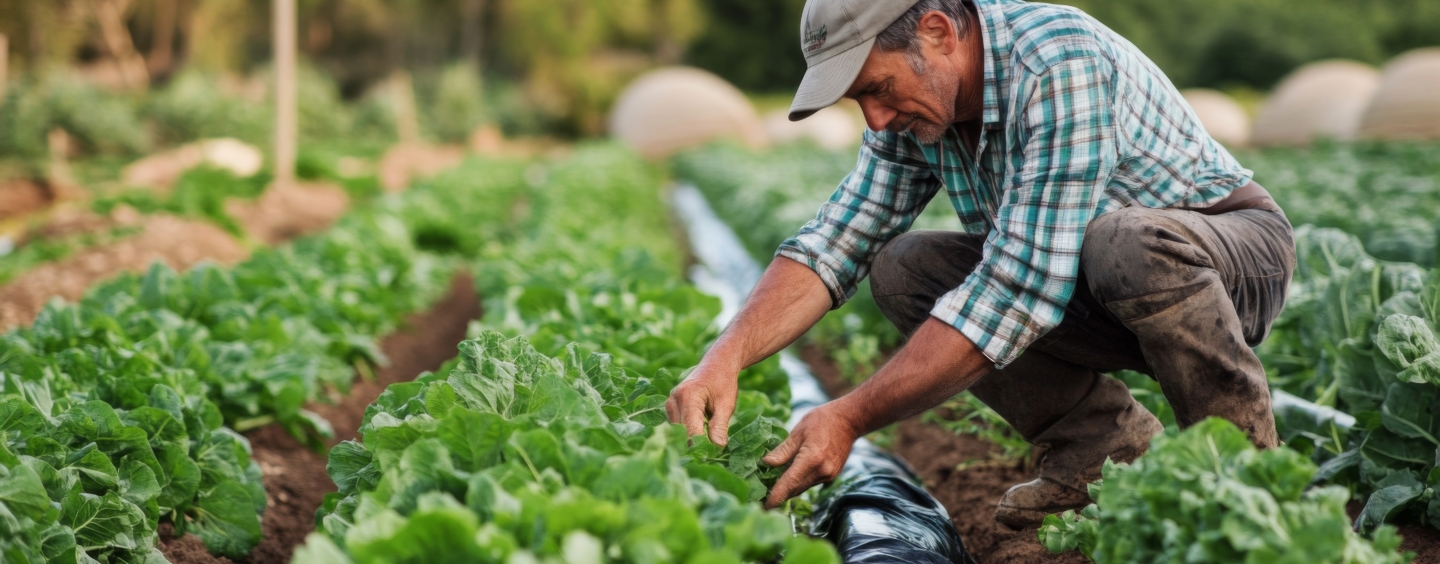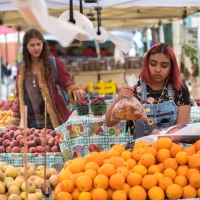Systemic Scarcity: The Intentional Financial and Food Exclusion of Immigrants

“Systemic Scarcity: The Intentional Financial and Food Exclusion of Immigrants”
Imagine moving to the United States in search of financial success, only to face the challenge of low wages at a full-time job and struggle to make ends meet in order to pay rent and put food on the table simultaneously. For over 625,000 undocumented families living in California, living below the poverty line, this is their reality. Undocumented families' annual income being below $26,246 isn’t a result of not working enough hours or lack of effort.1 Instead, it’s a direct result of policies and systemic structures that create barriers for those who hold an immigration status. Due to these systemic barriers, they are restricted in their access to food, financial support, and general basic necessities.
Labor Exploitation through the Immigration Reform and Control Act
Within the United States, there are about 8 million undocumented workers, most working low-wage jobs within domestic labor, food service, agriculture, and construction. Due to the Immigration Reform and Control Act, it is illegal for employers to knowingly hire immigrant workers. In order for companies to hire immigrants, they don’t report their employees' citizenship status.2 During the Covid-19 pandemic, the United States needed nurses to serve in overcrowded hospitals due to the rapid increase of patients. Shiny Lal, an immigrant nurse from India, came to the United States in search for work that would provide financial stability for her family. After being employed by MedPro, to serve COVID-19 patients, she began working in a hospital in Kentucky. Despite working in a field where she is at constant risk for her life to save others, she was underpaid and had an abusive supervisor. When she tried to leave her job, she realized she had signed a “stay-or-pay" contract when hired, forcing her to pay for the cost of her training and the money the company could potentially lose if she left early. As a result, MedPro expected Lal to pay about $40,000 if she left, leaving her unable to pay for these expenses to leave her exploitive job.3 Similar to Lal, employers continue to exploit immigrant workers through harsh working conditions, no paid overtime , and low wages, knowing that immigrant workers won’t report such harsh treatment as they aren’t legally hired or bonded to unexplained contracts. Although there are legal protections in place to protect workers, regardless of immigration status, many don’t report mistreatment out of fear of revealing their immigration status to the federal government.2.5 In addition, the Immigration Reform and Control Act, hinders immigrants' ability to work in higher-paying jobs and advance in their job status within companies. They are restricted from being hired by companies that grant immigrants such opportunities due to their lack of citizenship and the companies fear of facing legal consequences. Immigrants are ultimately denied the opportunity to escape poverty and make California’s average income of $50,300 a year.4 Thus, immigrant workers lack of employment opportunities only allows them to earn an income below the poverty, preventing them from affording basic necessities.
If Immigrants are facing food insecurity, can they apply to CalFresh?
Unlike many of those living in the United States, immigrants aren’t able to have access to food benefits, such as CalFresh. CalFresh is a supplement program that provides low- income families and individuals with monthly assistance in purchasing food, adding benefits to an Electronic Benefit Transfer card that can be used at grocery stores. When applying for CalFresh, the program considers the number of household members and income to address financial needs to the fullest extent possible. Despite being the largest food program in California, there are unfortunately limitations on who is eligible for such support.5 In order to receive CalFresh, Immigrants must have citizenship, a green card, refugee or asylum status. Having such restrictions excludes a large portion of the Immigrant population, such as those living in the United States with a student visa, Deferred Action for Childhood Arrivals, and an undocumented status, from having access to food benefits.6 Despite qualifying for CalFresh benefits, many immigrants do not apply due to fear of the Public Charge Law.
The Fear of the Public Charge Law
The Public Charge Law allows for immigration officials to see if the person applying for a green card has received government assistance through Supplemental Security Income, Temporary Assistance for Needy Families, or other cash aid assistance. If the applicant has, they didn’t pass the public charge test, deeming them as likely having to rely on government assistance as their main financial support.7 Despite CalFresh not falling into this category, many immigrants don’t enroll in safety net programs out of fear that they will lose their green cards or never be able to receive one. Around 16% of immigrants are misguided by information believing that CalFresh benefits are taken into account, while 58% remain unsure if it does.8 Due to a lack of information or misinformation about how CalFresh applies to the Public Charge Law, Immigrants who are eligible to apply often lack access to food as a result. Whereas those who don't qualify are completely denied the benefits of monthly support to purchase groceries.
Immigrants living in the United States, despite living in poverty, are denied the opportunity to obtain financial security and proper meals. Immigrants experiencing poverty is a direct outcome of systemic barriers, such as restrictions on qualification for government support and job opportunities. Policies implemented by the government, such as the Immigration Reform and Control Act and the Public Charge Law, actively prevent immigrants from having access to government support programs and achieving a sustainable income. Instead, they are subjected to work for low wages, experience extensive hours of work, and harsh working environments as a means of paying for basic necessities. Despite immigrants struggling to afford essential expenses, they don’t qualify for government support due to their citizenship status. If they or their children do qualify, they remain scared of applying out of fear that accepting aid can jeopardize their green card status. Thus, the government is actively contributing to financial and food disparities amongst immigrant and their families through its policies and eligibility qualifications.
References
1. Food4All. Food Insecurity Among Undocumented Immigrants in California & Exclusion From Nutrition Assistance Program: Among California’s Undocumented Immigrants, More Than Two In Five are Affected by Food Insecurity. Nourish California. Published August 25, 2025. Accessed September 11, 2025. https://nourishca.org/wp-content/uploads/2022/04/Food4All-FoodInsecurityBrief-April2022.pdf
2. Quijano J. Workplace Discrimination and Undocumented First-Generation Latinx Immigrants. Crown Family School of Social Work, Policy, and Practice. Published 2023. https://crownschool.uchicago.edu/student-life/advocates-forum/workplace-discrimination-and-undocumented-first-generation-latinx
3. Dempsey R. How “Stay-or-Pay” Contracts Are Used to Abuse Immigrant Workers | ACLU. American Civil Liberties Union. Published January 13, 2025. https://www.aclu.org/news/womens-rights/how-stay-or-pay-contracts-are-used-to-abuse-immigrant-workers
4. Median Household Income By State 2025. Datapandas.org. Published May 24, 2025. https://www.datapandas.org/ranking/median-household-income-by-state
5. Clinical Decision Support System. CalFresh. cdss.ca.gov. https://cdss.ca.gov/inforesources/calfresh
6. GetCalFresh. Immigrant guide. www.getcalfresh.org. Published July 2, 2025. https://www.getcalfresh.org/en/immigrants
7. Ashbrook A. Decreases in eligible immigrants’ SNAP participation show there’s more work to be done. Food Research & Action Center. Published January 16, 2023. https://frac.org/blog/snap-eligible-immigrant-families-part-one
8. Cifuentes V. As Chilling Effects of the Public Charge Rule Linger, How Can Health Systems Support Immigrant Families and Increase Their Access to Essential Services? | PolicyLab. Children’s Hospital of Philadelphia PolicyLab. Published September 26, 2024. https://policylab.chop.edu/blog/chilling-effects-public-charge-rule-linger-how-can-health-systems-support-immigrant-families
9. The Hidden Migrant Workforce: Comparing the Canadian and U.S. Temporary Foreign Worker Visa Programs. The ILR School | Cornell University. https://www.ilr.cornell.edu/mobilizing-against-inequality/post/hidden-migrant-workforce-comparing-canadian-and-us-temporary-foreign-worker-visa-programs
10. How NAFTA got Mexicans hooked on U.S. junk food. Dallas News. Published May 1, 2017. https://www.dallasnews.com/opinion/commentary/2017/05/01/how-nafta-got-mexicans-hooked-on-u-s-junk-food/
Tags



